

National Museum of Australia. Populate or perish When Japan entered the Second World War in December 1941 its troops quickly moved south, occupying much of South-East Asia and the Pacific.
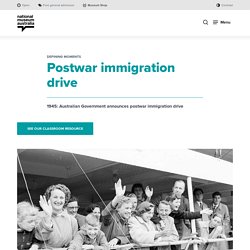
Singapore fell in February 1942 and Darwin was bombed shortly after. In Australia, the threat of invasion was very real and the country was more vulnerable than previously thought. These susceptibilities meant that well before the war ended on 14 August 1945, the government had begun considering policies that would boost Australia’s population and its defences. Arthur Calwell was appointed Australia’s first Minister for Immigration in July 1945. Calwell’s call for immediate migration was significant but perhaps even more important were the final sentences of his speech: ‘The door to Australia will always be open within limits of our existing legislation to the people from the various dominions, United States of America and from European continental countries’. The Refugee Project. Stories from migrants and refugees. 20160830 refugeesandmigrants. Why people leave - Refugee Council of Australia.
Immigration Stories : Immigration Place. Throughout history stories have been used to illuminate, to educate, to recount, to challenge and to engage.

Every individual’s life experience is unique and dynamic, particularly for those of us who have journeyed far from our homes to establish new lives in foreign countries. Australia’s migrant history has enabled us to develop into the strong nation we are today. Personal stories and anecdotes are an important opportunity to enrich the public record and to embellish our history. Immigration Place Australia encourages the collection of immigrant stories. National Museum of Australia - EXCURSION. Successful Immigration Stories of Migrants Australia and NZ - Migration Downunder.
Tony's story - Refugee Council of Australia. Actor, writer and director Tony Le Nguyen grew up in Can Tho, a city in southern Vietnam.
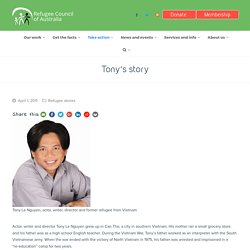
His mother ran a small grocery store and his father was as a high school English teacher. During the Vietnam War, Tony’s father worked as an interpreter with the South Vietnamese army. When the war ended with the victory of North Vietnam in 1975, his father was arrested and imprisoned in a “re-education” camp for two years. I had some idea that my dad was working for the previous government.
He was a teacher and interpreter and he said the new government didn’t like him that much and they would make life difficult… [but] I didn’t have any clue what a re-education camp was. With his father in prison, Tony’s mother became the sole provider for her seven children. I had to cross a small bamboo bridge to bring the rice to him. When Tony’s father was released from the camp, he decided that his family must leave Vietnam.
They managed to escape on their second attempt, narrowly evading border police. Refugee stories Archives - Refugee Council of Australia. National Museum of Australia. Interactive New Homes (2.3mb) (requires Flash) Learn about two ‘displaced persons’ who migrated to Australia from Europe after World War II and make a museum exhibition about their stories.
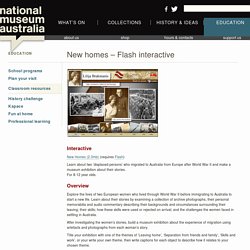
For 8-12 year olds. Overview Explore the lives of two European women who lived through World War II before immigrating to Australia to start a new life. After investigating the women’s stories, build a museum exhibition about the experience of migration using artefacts and photographs from each woman’s story. Title your exhibition with one of the themes of ‘Leaving home’, ‘Separation from friends and family’, ‘Skills and work’, or your write your own theme, then write captions for each object to describe how it relates to your chosen theme. Calling Australia home: refugees share their stories. Updated 24 Jun 2012, 2:19amSun 24 Jun 2012, 2:19am Australia has long provided refuge for those who have had to flee their home countries and prides itself on being a cultural mosaic, but for some the word 'refugee' conjures up a negative image.
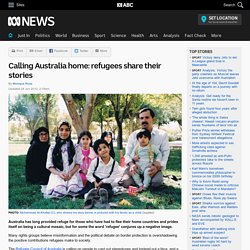
Many rights groups believe misinformation and the political debate on border protection is overshadowing the positive contributions refugees make to society. The Refugee Council of Australia is calling on people to cast out stereotypes and instead put a face, and a personality, to the refugee label. As Refugee Week is marked around the country, a handful of former refugees who now call Australia home share their stories with ABC News Online. Home - Destination: Australia - Sharing our post war migrant stories. Stories. I believe that institutional racism is a much greater problem in Australian society than we are prepared to acknowledge, and it informs behaviours without people even realising it – even in people who think they are embracing a multicultural society. … Continue reading Author: Charles Wong, urban dweller Migrants hope for a better life, but how far short do they ever think their expectations may fall?
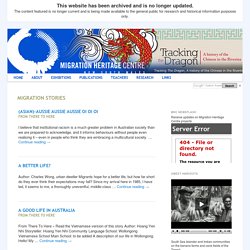
Since my arrival here in 1985, I have led, it seems to me, a thoroughly uneventful, middle-class … Continue reading From There To Here » Read the Vietnamese version of this story Author: Hoang Yen Nhi Storyteller: Hoang Yen Nhi Community Language School: Wollongong Vietnamese School Main School: to be added A description of our life in Wollongong. Hello! My … Continue reading. Stories from our collection. Fed Story. Migrant Stories - Live in Melbourne. Immigrant Stories - Museums Victoria. SBS World News. This map reveals the top three birthplaces for immigrants in suburbs and towns across Australia.

You can also access a map revealing birthplaces excluding English and New Zealand immigrants. Rollover suburbs with your mouse for detailed info. Zoom and drag for a view of other cities and the nation as a whole, or click on the following links: Mapping immigrants' birth places - Interactive Mapping Tool. Population and migration statistics in Australia. 7 December 2018 PDF version [429KB] Joanne Simon-DaviesStatistics and Mapping Section Introduction Compared with 100 years ago, Australians today are older, have fewer children, are more likely to live in urban areas, and are more likely to be born overseas in countries other than the United Kingdom.

Stimulated by the gold rushes of the 19th century, Australia's population had reached nearly four million by Federation in 1901. The rate of population growth has increased since the mid-2000s. This guide provides an overview of the drivers of Australia’s growing population and an introduction to the key concepts and terminology used. Counting the Australian population There are two ways the Australian Bureau of Statistics (ABS) determines the size and characteristics of the population: the five-yearly Census of Population and Housing (Census) and quarterly estimates of the resident population. Family History – Begin your journey. Researching family history is a favourite hobby for many people.

The National Archives holds many records in which you might find information about your ancestors. This is the place to come if your family members served in the Australian armed forces or if they migrated to Australia during the 20th century. You can view records online using RecordSearch or check original archival records in one of our Reading rooms.